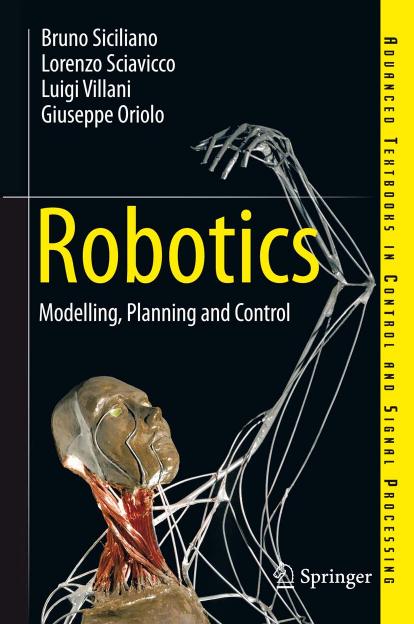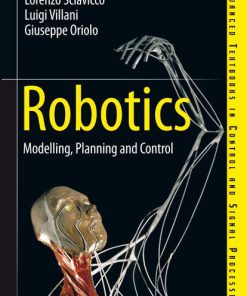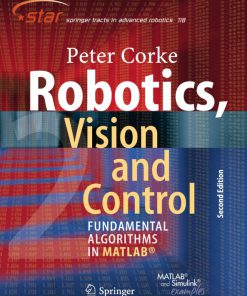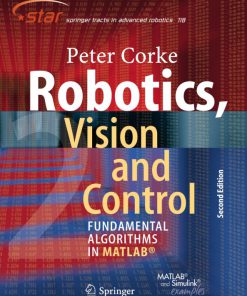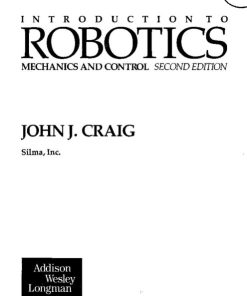Robotics Modelling Planning and Control 1st Edition by Bruno Siciliano, Lorenzo Sciavicco, Luigi Villani, Giuseppe Oriolo 1846286417 9781846286414
$50.00 Original price was: $50.00.$25.00Current price is: $25.00.
Authors:Bruno Siciliano • Lorenzo Sciavicco , Series:Mechatronics Engineering [134] , Author sort:Sciavicco, Bruno Siciliano • Lorenzo , Languages:Languages:eng , Published:Published:Nov 2008 , Publisher:Springer
Robotics Modelling Planning and Control 1st Edition by Bruno Siciliano, Lorenzo Sciavicco, Luigi Villani, Giuseppe Oriolo – Ebook PDF Instant Download/Delivery. 1846286417, 9781846286414
Full download Robotics Modelling Planning and Control 1st Edition after payment
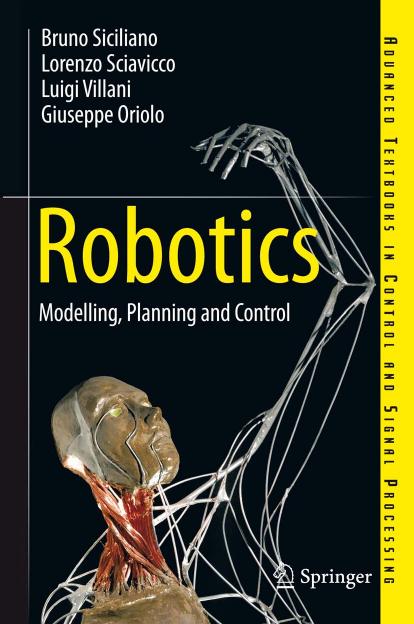
Product details:
ISBN 10: 1846286417
ISBN 13: 9781846286414
Author: Bruno Siciliano; Lorenzo Sciavicco; Luigi Villani; Giuseppe Oriolo
The classic text on robot manipulators now covers visual control, motion planning and mobile robots too! Robotics provides the basic know-how on the foundations of robotics: modelling, planning and control. The text develops around a core of consistent and rigorous formalism with fundamental and technological material giving rise naturally and with gradually increasing difficulty to more advanced considerations. The theory of manipulator structures presented in the early part of the book encompasses: • the fundamentals: kinematics, statics and trajectory planning; and • the technology of actuators, sensors and control units. Subsequently, more advanced instruction is given in: • dynamics and motion control of robot manipulators; • mobile robots; • motion planning; and • interaction with the environment using exteroceptive sensory data (force and vision). Appendices ensure that students will have access to a consistent level of background in basic areas such as rigid-body mechanics, feedback control, and others. Problems are raised and the proper tools established to find engineering-oriented solutions rather than to focus on abstruse theoretical methodology. To impart practical skill, more than 60 examples and case studies are carefully worked out and interwoven through the text, with frequent resort to simulation. In addition, nearly 150 end-of-chapter problems are proposed, and the book is accompanied by a solutions manual (downloadable from www.springer.com/978-1-84628-641-4) containing the MATLAB® code for computer problems; this is available free of charge to those adopting Robotics as a textbook for courses. This text is suitable for use in senior undergraduate and graduate courses in automation and computer, electrical, electronic and mechanical engineering courses with strong robotics content.
Robotics Modelling Planning and Control 1st Table of contents:
1 Introduction
1.1 Robotics
1.2 Robot Mechanical Structure
1.2.1 Robot Manipulators
1.2.2 Mobile Robots
1.3 Industrial Robotics
1.4 Advanced Robotics
1.4.1 Field Robots
1.4.2 Service Robots
1.5 Robot Modelling, Planning and Control
1.5.1 Modelling
1.5.2 Planning
1.5.3 Control
Bibliography
Basic textbooks
Specialized books
Edited collections on the state of the art of research
Scientific journals
Series of international scientific conferences
2 Kinematics
2.1 Pose of a Rigid Body
2.2 Rotation Matrix
2.2.1 Elementary Rotations
2.2.2 Representation of a Vector
2.2.3 Rotation of a Vector
2.3 Composition of Rotation Matrices
2.4 Euler Angles
2.4.1 ZYZ Angles
2.4.2 RPY Angles
2.5 Angle and Axis
2.6 Unit Quaternion
2.7 Homogeneous Transformations
2.8 Direct Kinematics
2.8.1 Open Chain
2.8.2 Denavit–Hartenberg Convention
2.8.3 Closed Chain
2.9 Kinematics of Typical Manipulator Structures
2.9.1 Three-link Planar Arm
2.9.2 Parallelogram Arm
2.9.3 Spherical Arm
2.9.4 Anthropomorphic Arm
2.9.5 Spherical Wrist
2.9.6 Stanford Manipulator
2.9.7 Anthropomorphic Arm with Spherical Wrist
2.9.8 DLR Manipulator
2.9.9 Humanoid Manipulator
2.10 Joint Space and Operational Space
2.10.1 Workspace
2.10.2 Kinematic Redundancy
2.11 Kinematic Calibration
2.12 Inverse Kinematics Problem
2.12.1 Solution of Three-link Planar Arm
2.12.2 Solution of Manipulators with Spherical Wrist
2.12.3 Solution of Spherical Arm
2.12.4 Solution of Anthropomorphic Arm
2.12.5 Solution of Spherical Wrist
Bibliography
Problems
3 Differential Kinematics and Statics
3.1 Geometric Jacobian
3.1.1 Derivative of a Rotation Matrix
3.1.2 Link Velocities
3.1.3 Jacobian Computation
3.2 Jacobian of Typical Manipulator Structures
3.2.1 Three-link Planar Arm
3.2.2 Anthropomorphic Arm
3.2.3 Stanford Manipulator
3.3 Kinematic Singularities
3.3.1 Singularity Decoupling
3.3.2 Wrist Singularities
3.3.3 Arm Singularities
3.4 Analysis of Redundancy
3.5 Inverse Differential Kinematics
3.5.1 Redundant Manipulators
3.5.2 Kinematic Singularities
3.6 Analytical Jacobian
3.7 Inverse Kinematics Algorithms
3.7.1 Jacobian (Pseudo-)inverse
3.7.2 Jacobian Transpose
3.7.3 Orientation Error
3.7.4 Second-order Algorithms
3.7.5 Comparison Among Inverse Kinematics Algorithms
3.8 Statics
3.8.1 Kineto-Statics Duality
3.8.2 Velocity and Force Transformation
3.8.3 Closed Chain
3.9 Manipulability Ellipsoids
Bibliography
Problems
4 Trajectory Planning
4.1 Path and Trajectory
4.2 Joint Space Trajectories
4.2.1 Point-to-Point Motion
4.2.2 Motion Through a Sequence of Points
4.3 Operational Space Trajectories
4.3.1 Path Primitives
4.3.2 Position
4.3.3 Orientation
Bibliography
Problems
5 Actuators and Sensors
5.1 Joint Actuating System
5.1.1 Transmissions
5.1.2 Servomotors
5.1.3 Power Amplifiers
5.1.4 Power Supply
5.2 Drives
5.2.1 Electric Drives
5.2.2 Hydraulic Drives
5.2.3 Transmission Effects
5.2.4 Position Control
5.3 Proprioceptive Sensors
5.3.1 Position Transducers
5.3.2 Velocity Transducers
5.4 Exteroceptive Sensors
5.4.1 Force Sensors
5.4.2 Range Sensors
5.4.3 Vision Sensors
Bibliography
Problems
6 Control Architecture
6.1 Functional Architecture
6.2 Programming Environment
6.2.1 Teaching-by-Showing
6.2.2 Robot-oriented Programming
6.3 Hardware Architecture
Bibliography
Problems
7 Dynamics
7.1 Lagrange Formulation
7.1.1 Computation of Kinetic Energy
7.1.2 Computation of Potential Energy
7.1.3 Equations of Motion
7.2 Notable Properties of Dynamic Model
7.2.1 Skew-symmetry of Matrix ˙B − 2C
7.2.2 Linearity in the Dynamic Parameters
7.3 Dynamic Model of Simple Manipulator Structures
7.3.1 Two-link Cartesian Arm
7.3.2 Two-link Planar Arm
7.3.3 Parallelogram Arm
7.4 Dynamic Parameter Identification
7.5 Newton–Euler Formulation
7.5.1 Link Accelerations
7.5.2 Recursive Algorithm
7.5.3 Example
7.6 Direct Dynamics and Inverse Dynamics
7.7 Dynamic Scaling of Trajectories
7.8 Operational Space Dynamic Model
7.9 Dynamic Manipulability Ellipsoid
Bibliography
Problems
8 Motion Control
8.1 The Control Problem
8.2 Joint Space Control
8.3 Decentralized Control
8.3.1 Independent Joint Control
8.3.2 Decentralized Feedforward Compensation
8.4 Computed Torque Feedforward Control
8.5 Centralized Control
8.5.1 PD Control with Gravity Compensation
8.5.2 Inverse Dynamics Control
8.5.3 Robust Control
8.5.4 Adaptive Control
8.6 Operational Space Control
8.6.1 General Schemes
8.6.2 PD Control with Gravity Compensation
8.6.3 Inverse Dynamics Control
8.7 Comparison Among Various Control Schemes
Bibliography
Problems
9 Force Control
9.1 Manipulator Interaction with Environment
9.2 Compliance Control
9.2.1 Passive Compliance
9.2.2 Active Compliance
9.3 Impedance Control
9.4 Force Control
9.4.1 Force Control with Inner Position Loop
9.4.2 Force Control with Inner Velocity Loop
9.4.3 Parallel Force/Position Control
9.5 Constrained Motion
9.5.1 Rigid Environment
9.5.2 Compliant Environment
9.6 Natural and Artificial Constraints
9.6.1 Analysis of Tasks
9.7 Hybrid Force/Motion Control
9.7.1 Compliant Environment
9.7.2 Rigid Environment
Bibliography
Problems
10 Visual Servoing
10.1 Vision for Control
10.1.1 Configuration of the Visual System
10.2 Image Processing
10.2.1 Image Segmentation
10.2.2 Image Interpretation
10.3 Pose Estimation
10.3.1 Analytical Solution
10.3.2 Interaction Matrix
10.3.3 Algorithmic Solution
10.4 Stereo Vision
10.4.1 Epipolar Geometry
10.4.2 Triangulation
10.4.3 Absolute Orientation
10.4.4 3D Reconstruction from Planar Homography
10.5 Camera Calibration
10.6 The Visual Servoing Problem
10.7 Position-based Visual Servoing
10.7.1 PD Control with Gravity Compensation
10.7.2 Resolved-velocity Control
10.8 Image-based Visual Servoing
10.8.1 PD Control with Gravity Compensation
10.8.2 Resolved-velocity Control
10.9 Comparison Among Various Control Schemes
10.10 Hybrid Visual Servoing
Bibliography
Problems
11 Mobile Robots
11.1 Nonholonomic Constraints
11.1.1 Integrability Conditions
11.2 Kinematic Model
11.2.1 Unicycle
11.2.2 Bicycle
11.3 Chained Form
11.4 Dynamic Model
11.5 Planning
11.5.1 Path and Timing Law
11.5.2 Flat Outputs
11.5.3 Path Planning
11.5.4 Trajectory Planning
11.5.5 Optimal Trajectories
11.6 Motion Control
11.6.1 Trajectory Tracking
11.6.2 Regulation
11.7 Odometric Localization
Bibliography
Problems
12 Motion Planning
12.1 The Canonical Problem
12.2 Configuration Space
12.2.1 Distance
12.2.2 Obstacles
12.2.3 Examples of Obstacles
12.3 Planning via Retraction
12.4 Planning via Cell Decomposition
12.4.1 Exact Decomposition
12.4.2 Approximate Decomposition
12.5 Probabilistic Planning
12.5.1 PRM Method
12.5.2 Bidirectional RRT Method
12.6 Planning via Artificial Potentials
12.6.1 Attractive Potential
12.6.2 Repulsive Potential
12.6.3 Total Potential
12.6.4 Planning Techniques
12.6.5 The Local Minima Problem
12.7 The Robot Manipulator Case
Bibliography
Problems
Appendices
A Linear Algebra
A.1 Definitions
A.2 Matrix Operations
A.3 Vector Operations
A.4 Linear Transformation
A.5 Eigenvalues and Eigenvectors
A.6 Bilinear Forms and Quadratic Forms
A.7 Pseudo-inverse
A.8 Singular Value Decomposition
Bibliography
B Rigid-body Mechanics
B.1 Kinematics
B.2 Dynamics
B.3 Work and Energy
B.4 Constrained Systems
Bibliography
C Feedback Control
C.1 Control of Single-input/Single-output Linear Systems
C.2 Control of Nonlinear Mechanical Systems
C.3 Lyapunov Direct Method
Bibliography
D Differential Geometry
D.1 Vector Fields and Lie Brackets
D.2 Nonlinear Controllability
Bibliography
E Graph Search Algorithms
E.1 Complexity
E.2 Breadth-first and Depth-first Search
E.3 A* Algorithm
People also search for Robotics Modelling Planning and Control 1st:
robotics modelling planning and control pdf
robotics modelling planning and control
robotics modelling planning and control solution manual pdf
robotics modelling planning and control bruno siciliano pdf
You may also like…
eBook PDF
Introduction to Robotics Mechanics and Control 2nd edition by John Craig 0201095289 978-0201095289

